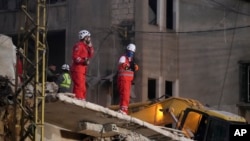Israel-Hezbollah cease-fire begins in Lebanon

A cease-fire between Israel and the Lebanon-based militant group Hezbollah went into effect early Wednesday, bringing a halt in fighting that U.S. and French leaders said could create a path to another truce in the Gaza Strip.
As the cease-fire went into place, there were streams of cars heading toward southern Lebanon where months of intensified fighting and Israeli evacuation orders forced people to flee their homes.
Israel’s military warned people to stay away from the villages where it had previously ordered evacuations.
The United States, along with France, played a key role in brokering the settlement, which Israel’s Security Cabinet approved late Tuesday.
U.S. President Joe Biden called the ceasefire “a critical step … to end the violence” in the Mideast. He said that Iran and its proxies, Hezbollah in Lebanon and Hamas militants in Gaza, “have paid a heavy price” in more than a year of fighting Israeli forces.
He said the Israeli-Hezbollah agreement “is designed to be a permanent cessation of hostilities.”
Watch related video by Patsy Widakuswara:
But Biden warned, “Let me be clear, if Hezbollah or anyone else breaks the deal and pose a direct threat to Israel, then Israel retains the right to self-defense consistent with international law, just like any country in facing a terrorist group pledged to that country’s destruction.”
The outgoing U.S. leader, with less than two months remaining in his four-year term, said that with Hezbollah agreeing to end its attacks on Israel, “Hamas has a choice to make. Their only way out is to release the hostages [it is holding in Gaza], including American citizens.”
“Over the coming days, the United States will make another push for Turkey, Egypt, Qatar, Israel and others to achieve a ceasefire in Gaza,” Biden said.
Israeli Prime Minister Benjamin Netanyahu said he favored a truce with Hezbollah so Israel could focus its attention on the broader threat posed by Iran, refresh its forces and isolate Hamas in its ongoing fight against Israel in Gaza.
Netanyahu vowed that if Hezbollah renews its attacks on Israel or rearms itself, Israel would immediately resume its bombardment of militant sites in Lebanon.
“The length of the ceasefire will depend on what happens in Lebanon,” Netanyahu said. “With the full understanding of the United States, we are preserving full military freedom of action — if Hezbollah breaks the agreement and seeks to arm itself, we will attack.”
Netanyahu’s move toward a halt in nearly 14 months of fighting with Hezbollah came after a day of Israeli attacks on militant targets in Lebanon.
Hours before the cease-fire went into effect, Israeli forces struck along the Lebanon-Syria border in attacks that Syria’s state news agency said killed at least six people.
The Israeli military said it struck transit routes between Syria and Lebanon that were used to deliver weapons to Hezbollah.
Israel has for years conducted airstrikes in Syria in a campaign to disrupt weapons flows to the Iran-backed militants.
The Syrian Arab Red Crescent said one of its volunteers was killed and another injured in the strikes at the border crossings, which happened as they were trying to rescue wounded people. A statement from the organization said several ambulances were damaged, and it called on all sides in the conflict to respect humanitarian law and protect humanitarian workers.
Hezbollah began attacking Israel in October 2023 in support of Hamas militants fighting their war with Israel in Gaza.
The ceasefire deal, brokered by U.S. and French diplomats, includes a halt in the fighting and a 60-day period in which Israel and Hezbollah would both withdraw from southern Lebanon.
Ahead of the deal, U.S. Secretary of State Antony Blinken told reporters at a news conference at a G7 foreign ministers meeting in Italy that the ceasefire was “the best way to guarantee there is peace, there is stability.”
Blinken said the deal to end Israel-Hezbollah fighting also could push Hamas to reach a long-stalled cease-fire pact in Gaza because it would no longer have an Iranian-funded ally fighting Israel on a second front in northern Israel and Lebanon.
Under the cease-fire, Israeli forces are obligated to retreat south of the Lebanon-Israel border, while Hezbollah moves north of the Litani River. The plan calls for the Lebanese army, which is not involved in the Israeli-Hezbollah fighting, to patrol the region between the two warring sides.
The fighting in Lebanon has caused a humanitarian crisis, displacing hundreds of thousands of people.
On Monday, the United Nations World Food Program announced that it has provided emergency aid to more than a half million people in Lebanon since the conflict began. The WFP said it plans to reach 1 million people and is continuing to work to deliver critical assistance to affected communities.
In the October 2023 attack on Israel that ignited the Middle East warfare, Hamas militants killed 1,200 people and captured about 250 hostages. Israel says it believes Hamas is still holding 101 hostages, including 35 the military says are dead.
Israel’s counteroffensive in Gaza has killed more than 44,235 Palestinians, according to the territory’s health ministry, which does not distinguish between combatants and civilians in its count. The Israeli military says the death toll includes thousands of Hamas fighters, while the health ministry says more than half are women and children.
Hamas and Hezbollah have been designated as terror groups by the United States, the United Kingdom and other Western countries.
VOA State Department bureau chief Nike Ching, United Nations correspondent Margaret Besheer and White House bureau chief Patsy Widakuswara contributed to this report. Some material in this report came from The Associated Press, Agence France-Presse and Reuters.






